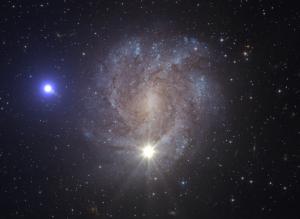Blog
Go Speed Racer! Go!
10 March 2015
 Science
ScienceOur Sun orbits the center of the Milky Way with a speed of about 220 km/s. Some stars are faster, and some are slower, but most stars have a roughly similar orbital speed. A few stars, however, have much higher speeds. These hypervelocity stars have speeds of 600 km/s or more, which is fast enough to escape our galaxy over time. Just how stars get such tremendous speeds is not clear, but one idea is that they made a close approach to the black hole in the center of our galaxy. Now the fastest star yet has been discovered, and it wasn’t given its speed by a black hole.
The results were recently published in Science.1 In the work the team outlines how they measured the radial velocity of the star (the speed along our line of sight) using Doppler measurements, then looked at past position measurements of the star to get its proper motion through the sky. Combining these the team determined the speed and direction of the star through the galaxy. They found it is traveling at about 1,200 km/s, and that its direction is such that it could not have gained speed from the central black hole of our galaxy.
They also found that the star was a bit unusual. It is a compact helium star with a rapid rotation. This means it likely formed as part of a close binary with another star. The likely scenario is then that it was a close companion to a white dwarf star, and as as their gravitational dance allowed some of the helium star’s outer layers to be captured by the white dwarf, it eventually triggered the white dwarf to explode as a supernova. The star was then ejected with a high speed.
So now we know how some hypervelocity stars can gain such tremendous speed.
Geier, S., et al. “The fastest unbound star in our Galaxy ejected by a thermonuclear supernova.” Science 347.6226 (2015): 1126-1128. ↩︎